SC Rewind: Roosevelt Closes Forever
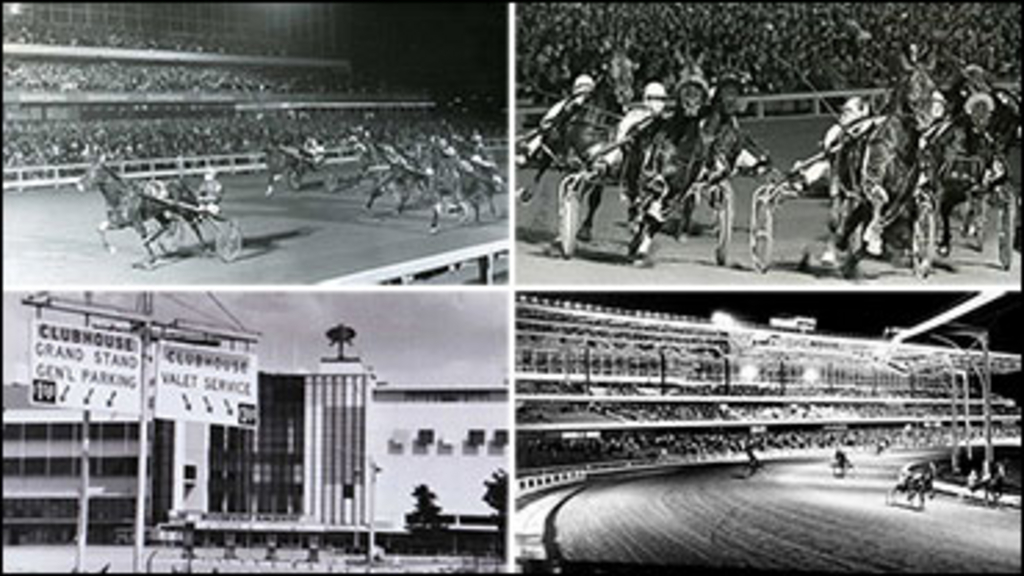
In this week's Rewind Robert Smith recalls a rather sad happening from 30 years ago when the fabled Roosevelt Raceway in Westbury, New York closed its doors forever. His piece includes a large number of photographs that show various aspects of this once great racing centre down through the years.
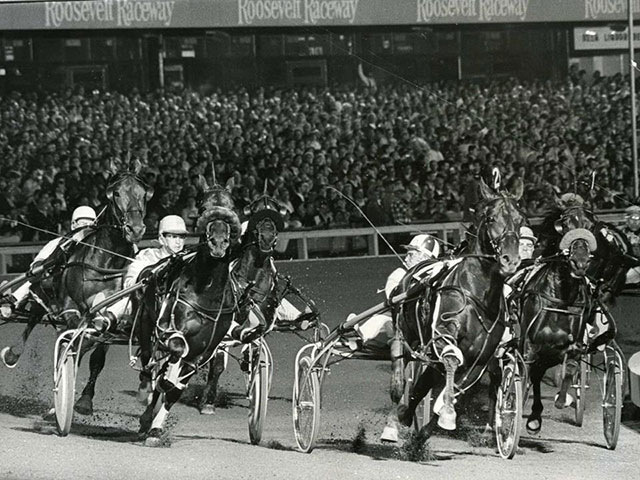
A field of horses heads into the first turn at Roosevelt as a packed grandstand is visible in the background. That looks a lot like George Sholty (2) on the lead.
Thirty years ago this coming week on the evening of June 15, 1988 the once great and equally famous Roosevelt Raceway closed its doors. Not for the week or the season, but forever. The once mighty centre of harness racing located on Long Island, New York would be no more. As Majestic Andrew driven by Rejean Daigneault crossed the finish line a winner, the greatest chapter in the sport of harness racing came to a sad end. The "death" had been a slow and painful process as various happenings starting with OTB in 1971 had slowly but surely led to this day. The value of the land where the track was located undoubtedly became the deciding factor.
Way back almost fifty years prior to this in the fall of 1940, Roosevelt Raceway opened its doors to a new brand of racing; night-time racing and at the same location for weeks at a time. The sport heretofore had been conducted at County Fairs and special exhibitions but never like this. A man named George Morton Levy was the guiding hand that led this rebirth of the sport into the modern era. After struggling mightily through the early years (which were also complicated by World War II) he saw his plan come to fruition. Several times on the brink of financial disaster he was able to persevere. The legalization of parimutuel wagering made it all worthwhile.
On the evening of September 2, 1940 Roosevelt hosted its first night of harness racing. It was to have been a few nights earlier but with only seven horses entered, opening day had to be delayed a bit. A crowd reported at 5,000 watched and wagered $40,742. A horse named Martha Lee, which I believe was a Canadian-bred mare, won the first race. It was just a taste of the many great happenings that would occur in the years ahead. Another innovation was introduced as single heats were held as opposed to the old system of the same horses racing in multiple heats.
As the war ended in 1946 came the next great step and that was the introduction of the mobile starting gate. Racing under the lights and the introduction of a proper starting method soon brought out the crowds in record numbers. In its heyday, the 1960's, attendance averaged 24,000 people a night. On weekends and special race days the numbers escalated drastically. In 1960 when the track hosted the International Trot, a record crowd of 54,861 people set the all-time attendance record.
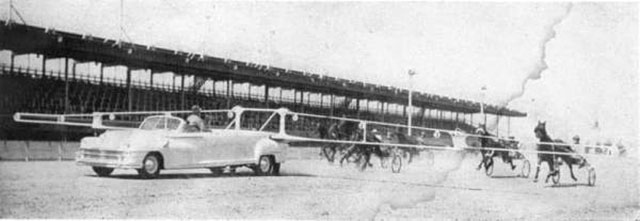
The new and revolutionary Philips starting gate is shown in its debut season of 1946. The gate's introduction greatly improved the popularity of the sport and allowed for fair starts and predictable post times. (Harness Horse)
By 1950 the aim of every horse owner was to race at Roosevelt, to capture a piece of the large purses and glory that went with competing and winning at what was considered the most palatial racetrack in the country and perhaps the world. Every top horseman dreamed of stabling and racing at this great mecca of horse racing. Originally built for auto racing, the track was retrofitted for harness racing and went through the first 15 years of its existence without a wholesale rebuild. In 1956 a major rebuild took place and RR as it was known enjoyed a new era of greatness.
At the height of its popularity Roosevelt had facilities unheard of before or since. It boasted a 14-bed hospital with a fully-functional operating room, radio and television broadcast rooms and multiple huge restaurants run by Harry M. Stevens Inc. Closed circuit television coverage of each race was broadcast throughout the grandstand. While that would seem commonplace in today's world it certainly was not back then. Whatever was the latest in the sport, it was usually introduced at Roosevelt. It was quite simply just the place to be whether you were a fan, an owner or anyone involved in any aspect of harness racing.
Throughout its entire history Canadian horse people played a major role in the annual racing happenings at Roosevelt. Dating back to the days of Clint Hodgins, Del MacTavish Sr., Morrie MacDonald, The Flemings and many others. In the modern days Johnny Chapman, Bud Gilmour, Herve Filion, Mike LaChance, Ray Remmen and John Campbell to name a few competed at the very top levels.
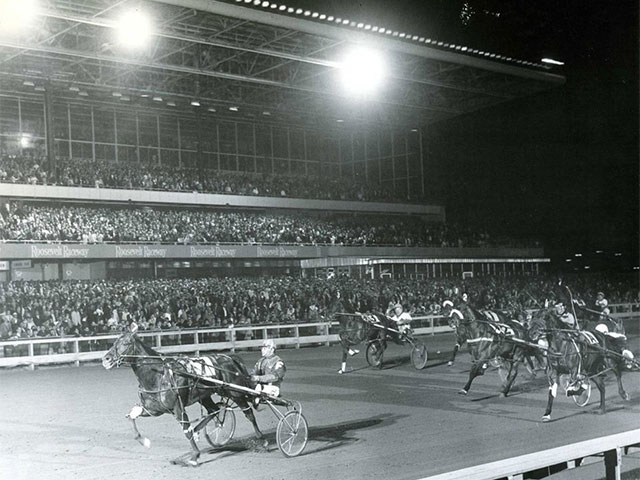
The unmistakable image of Herve Filion heading to another win at Roosevelt. Pictures like this remind us of just how popular and exciting harness racing was at Roosevelt. The customary huge crowd looks on.
In 1963 the track experienced one of the most horrible incidents in the history of the sport when fans rioted over the outcome of a race. The happenings of that evening are described in the track's history as follows:
"On November 8, 1963, only two horses finished following a mid-race crash. The race was declared official, which angered many of the 23,127 fans in attendance that night, setting off a riot. First throwing bottles and other debris, the fans then began jumping over the railing, smashing the tote board, and then attacking first the judges booth and then the police who attempted to interfere. After the fans began to set fires, arriving firemen set their hoses on the rioters to push them back. 15 people were treated for injuries."
For many decades Roosevelt played host to the sport's top events for both pacers and trotters. It was the original home to the Messenger Pace first held in 1956, won by Belle Acton driven by Billy Haughton -- one of the track's all-time great drivers. Many other great races were held there including The Dexter Cup. In time the track lost its appeal and popularity. Once considered too large to fail, it became too big to survive.
The crowds diminished, the facilities became run down and broken promises about keeping the track open led to the unfortunate closure. The escalation in land values coupled with the lack of interest in operating the track led to the END. Thirty short years ago the name of Roosevelt Raceway was added to the list of famous racetracks CLOSED. Today nothing tangible remains of this once greatest centre of harness racing. Many great old photos and videos are our only reminders of almost a half century of history and great performances at the highest level possible. Anyone who ever attended an evening of racing at this great location shares in a special part of our sport's long and colourful history.
The following is a collection of old photographs all taken at Roosevelt Raceway at various times during its nearly 50 years as the sport's premiere showplace.
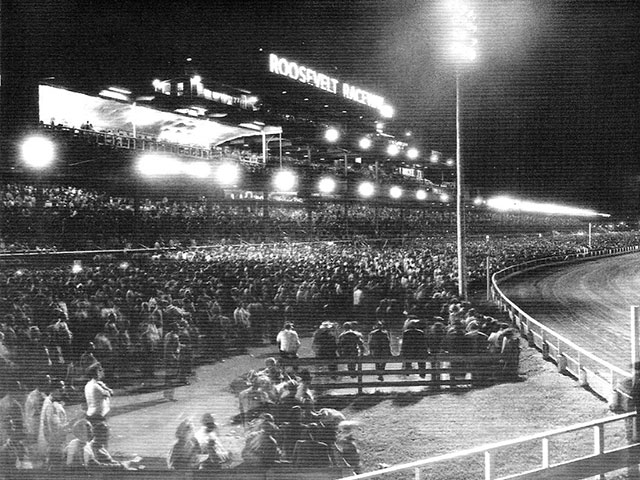
A view of the famous Roosevelt Raceway as a huge crowd enjoys an evening of racing in 1955
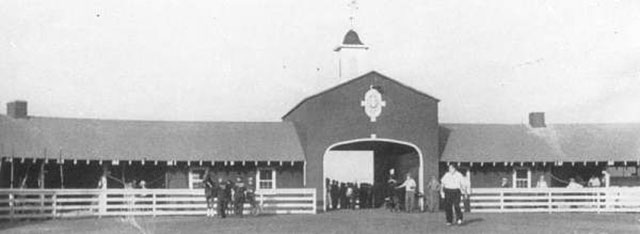
Above is a frontal view of the Roosevelt paddock as it appeared in 1941 the second season of operation (Harness Horse)
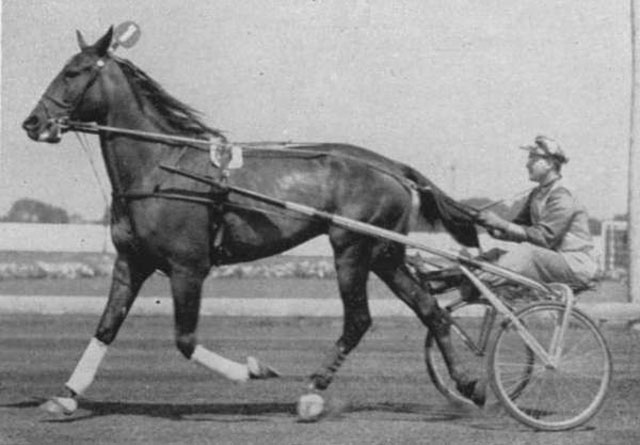
One of the first horses to achieve success at Roosevelt was a trotter named Reveler handled by Delvin Miller one of the early drivers to compete at the newly opened track (Harness Horse)
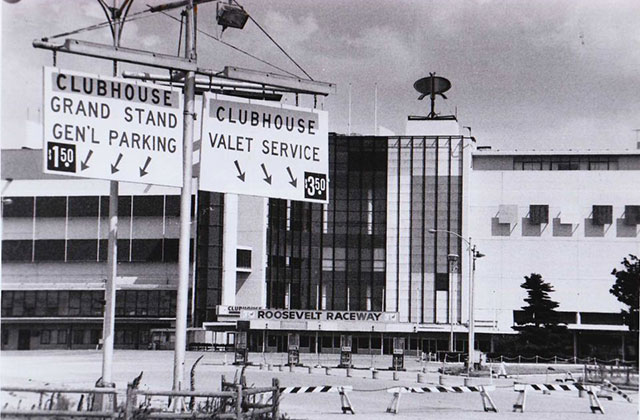
A view of the entrance to Roosevelt
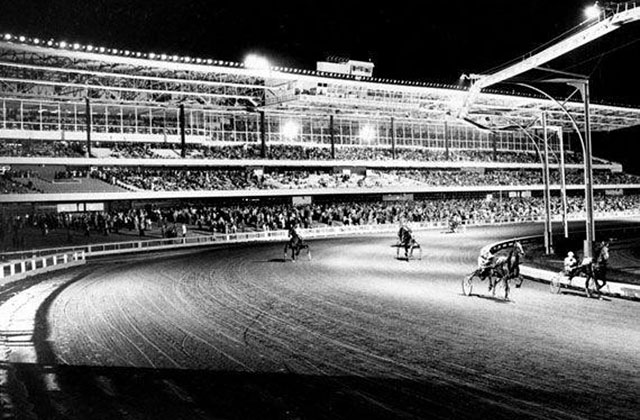
With the huge grandstand in the background horses go their warm up miles at Roosevelt in this 1950's shot from the clubhouse turn
Who is it?
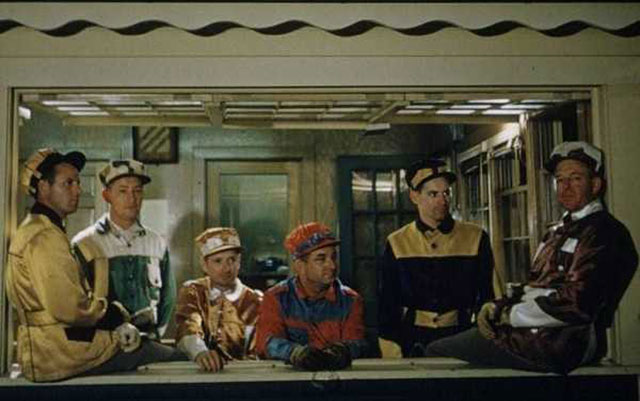
The driver's room at Roosevelt saw every great reinsman of the day either as a regular or guest participant. This 1958 shot captured a group of pretty famous horsemen. Can you put a name on each of the six? The correct answers will appear during the coming week.
Bonus Photo
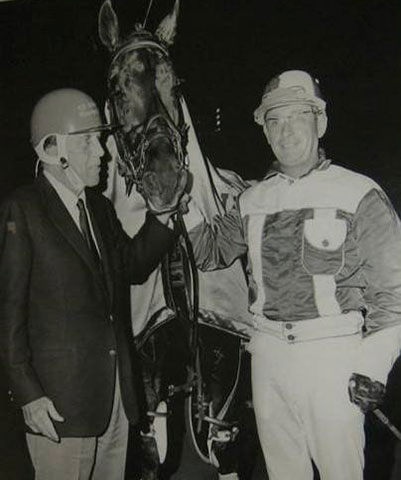
Can you name these two famous personalities, both regulars at Roosevelt?


I shall always remember my
I shall always remember my arrival at Roosevelt. I arrived early in the evening and was just getting out of the car to go get my license. A field of horses was finishing and the roar of that huge crowd made my pulse quicken and the hair on my neck stand straight. That was 1977.
I was training a string there the last summer they were open and had the honor of winning a race on what I recall was their final card. Jimmy Marohn win with Fog Patch; a horse my father owned. The thrill of winning was tamped down by the knowledge that this was a great raceway's last hurrah.
This week's featured photo
This week's featured photo taken at the old Roosevelt Raceway paddock driver's room captures quite a bit of Harness Racing history. Pictured from left to right are Richard Thomas (Fulla Napoleon), Billy Haughton, Joe O'Brien, Luther Lyons (of Adios Harry fame), Stanley Dancer and John Simpson Sr. (Courtesy of Roosevelt Raceway HOF).
The bonus photo was correctly identified as Ed Sullivan of Sunday night TV fame and also a harness racing advocate along with the great Billy Haughton, making it as someone pointed out "a really big shew" **
Thanks to all and I hope everyone watched the video; it is a great piece of history very well presented.
**This is not a typo that's how Ed Sullivan pronounced "Show".
Great read Robert! I believe
Great read Robert! I believe the drivers are from left to right; Delvin Miller, William Haughton, Joe O'Brien, Ralph Baldwin, Stanley Dancer, and John Simpson. Keep up the great work, I really enjoy reading these!
I don’t know where you get
I don’t know where you get all your stories from Robert but we really enjoy reading them. What a thrill it must have been for those drivers to drive in front of crowds of 30-40-50 thousand fans. The picture of the two gentlemen holding the horse by the head is definitely Ed Sullivan and Billy Haughton. The picture of the six drivers: I am quite sure of 4 of them but not so sure of the others 2. Second from the left is Billy Haughton to Billy’s left sitting is Joe O’Brien to the far right is John Simpson and to his right looking at him is Stanley Dancer. The other two is only a guess. I think the gentleman to Stanley Dancer's right is Jimmy Jordan. And to Billy Haughton’s right is Wendel Wathen Jr.
I think the guy 3rd from the
I think the guy 3rd from the left is Joe O'Brien from PEI Canada.
With Ed there is was a
With Ed there is was a "Really big show"
Ed Sullivan and Billy
Ed Sullivan and Billy Haughton
Bonus Photo... Ed Sullivan
Bonus Photo... Ed Sullivan and Billy Haughton